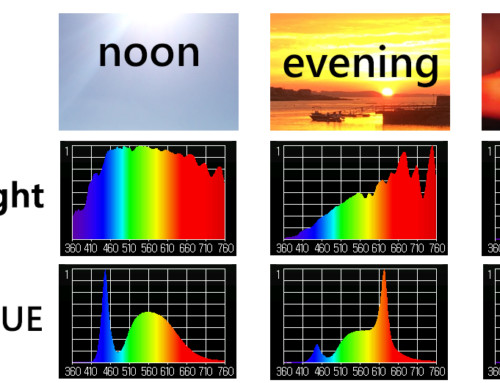Light has a profound impact on the way we look, and the way we see the world around us. It’s no accident that we look our best at sunset, or by candle light = natural light is beauty light! The rich red light of sunlight highlights skin tones, our lips and naturally softens our features. By contrast the blue-rich bright light of the noon-day sun is ‘revealing’ and tends to draw out our eye color, as well as fine details in our face and skin. Similarly, the artificial light in our interior spaces can dramatically alter our appearance. Old-fashioned incandescent and halogen bulbs emit warmer, red-rich light which is flattering. By contrast the cold light of fluorescents and most LEDs is harsh. As the images below illustrate, the light in our environment colors the way we are seen by the people around us.
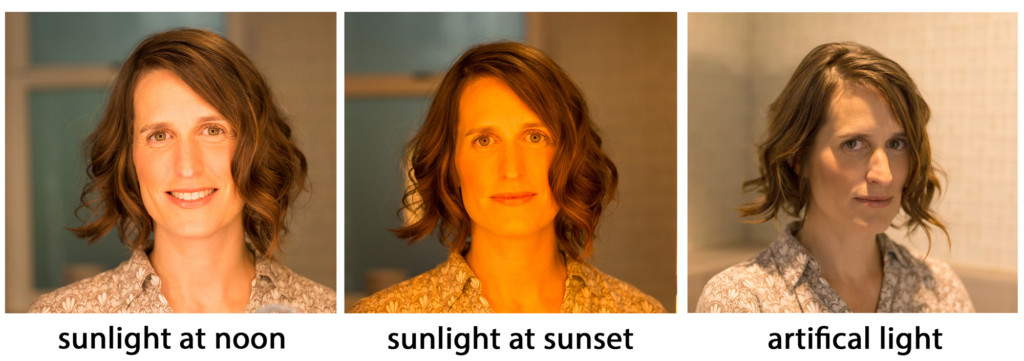
Light has a profound impact on how we look = natural light is flattering (beauty light), most artificial light is not!
Our eyes ‘see’ by detecting the light which is reflected off of objects. Like the red apple in the figure below, our skin is rich with blood, which reflects red light = so our skin looks the best when illuminated with warm red-rich light. When our face is illuminated by cooler blue-rich daylight, there is roughly an equal amount of blue, green and red light to reflect, which brings details into sharp focus, and washes out our skin tones. The light from an office fluorescent has an unnatural mix of blue and green colors and therefore makes us look pale or even ghostly. In an extreme example think of how you look in an airplane bathroom mirror. This is basic physics at work = the light illuminating our face must contain a natural balance of colors, so that these can be reflected off of our face, and then seen by the people around us.
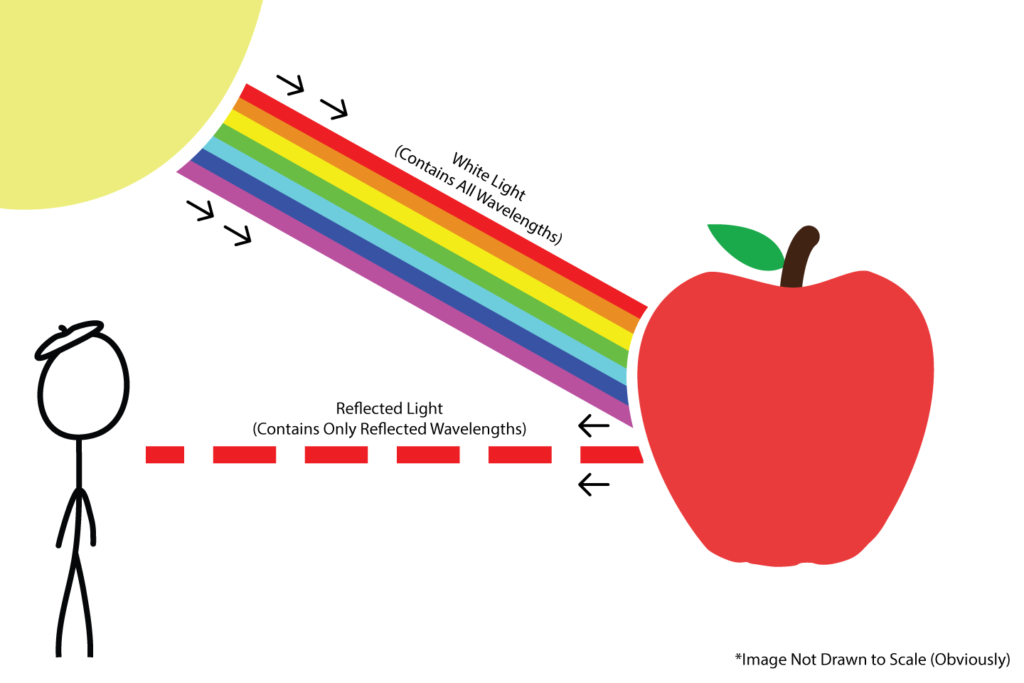
The colors we see are due to the light which is reflected off of an object! Like a red apple, our skin tones contain a lot of red (the color of blood) so we look our best when illuminated by warm red-rich light. (Figure excerpted from: https://springsemester2015artz363.wordpress.com/color/)
Make-up artists understand the interaction between light and skin and recommend different formulations for office or daylight (more blues), than for an intimate candle light dinner (more reds). Restaurants are deliberately lit with candle light, or soft warm incandescent bulbs to make the dining experience feel cozy, and their patrons look attractive – they understand the value of beauty light. Retailers choose cool white lights to highlight outdoor wear (blues and whites), or warm white lights to highlight fall colors and earth tones. Designers will choose a different mix of light and color to make spaces feel light and airy or cozy and intimate. We can make choices to make ourselves and our homes and offices more attractive – see below for some simple guidelines!
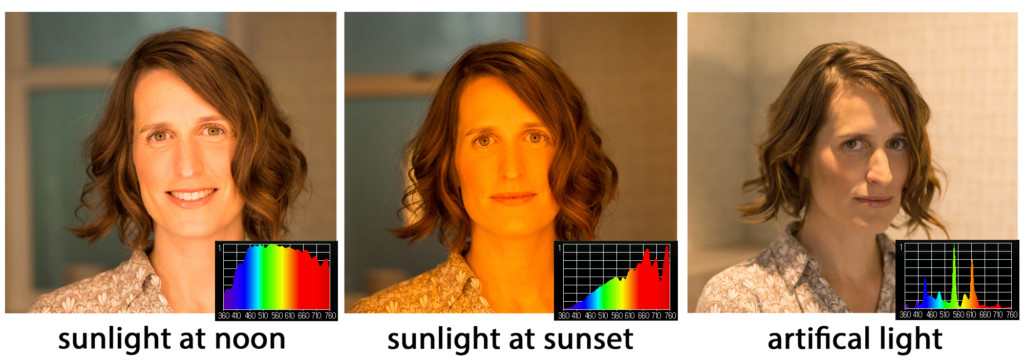
We look our best with natural light (natural light is rich in red light = healthy skin tones). Fluorescent light doesn’t contain enough red light, and has an unnatural balance of colors, making us look ghostly.
Natural light such as daylight, sunset and candle light are rich in red light and contain a natural balance of all the colors in the rainbow. Natural light is the gold standard for beauty light. Not all artificial lights are created the same, some are noticeably more flattering than others. The biggest issue with most artificial lights is that they generally do not emit enough red to make us look naturally healthy. To make matters worse, most modern light bulbs (LED and fluoresecent) are optimized for energy efficiency which means they emit too much green light, giving everything around them a greenish hue. The human vision response peaks in the green so manufacturers get more ‘credit’ for delivering extra green light. While this boosts energy efficiency, it makes most modern LED and fluorescent light sources ugly and unflattering. Net-net natural light is fundamentally different than the light from most artificial sources = natural light is beauty light!
rules of thumb for choosing high quality light sources:
(1) the more red light a light source emits the more flattering that light will be
> choose ‘warm-white’ products to look your best (2700-3000K color temperature)
(2) lights which emit a natural balance of all the colors of the rainbow are the most flattering
> avoid fluorescent and low-quality LED bulbs since they deliver an unnatural mix of colors
> choose ‘high CRI’ products to look your best (CRI of >90 – measure of color quality)
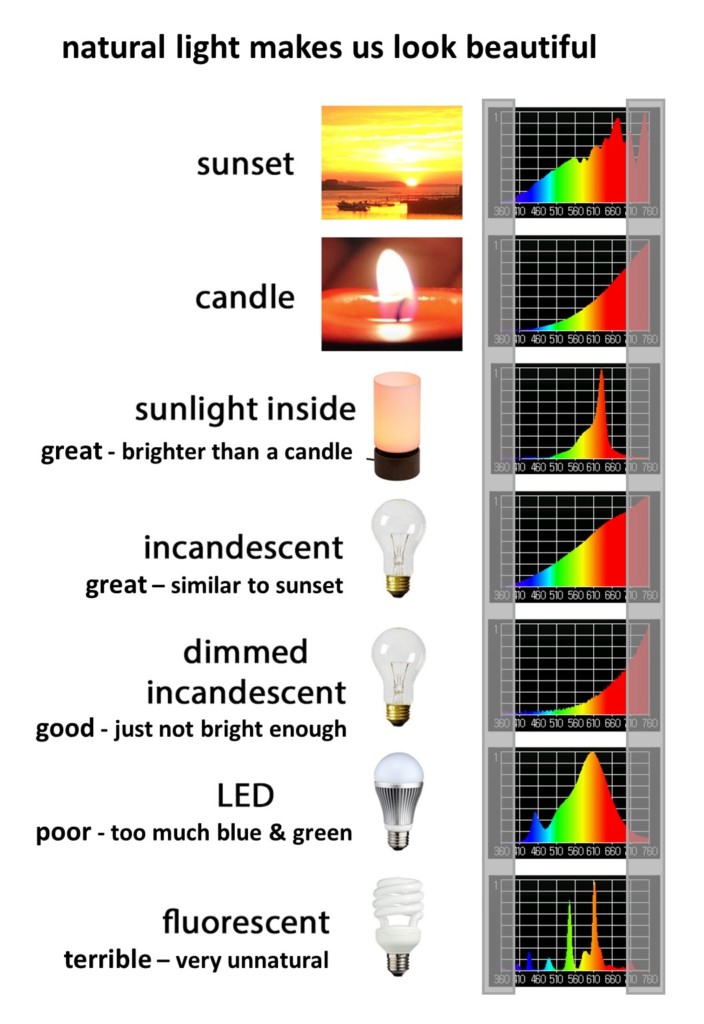
INFOGRAPHIC comparing natural and artificial light. Natural beauty light is rich in red and contains a balance of all the colors of the rainbow. Most artificial light sources do not emit enough red, and provide an unnatural mix of colors. We look (and feel) our best with natural light!!
The infographic above ranks the quality of light sources by how flattering they are for faces and skin. As you can see in the graphs, sunset and candle light are rich and red light and contain a natural balance of all the colors of the rainbow. Old-fashioned incandescent bulbs, and Sunlight Inside also emit light which is rich in red, with spectra similar to the light from candles. By contrast, the light from ‘warm-white’ LED bulbs contains an unnatural amount of blue and green, and too little red. When buying light bulbs, be sure to choose ‘warm white’ (2700K) AND ‘high CRI’ (CRI>90) to get a more natural spectrum. CRI stands for ‘color rendering index’ and is a proxy for light quality – the higher the CRI the better more flattering the light. Fluorescents only provide a partial spectrum, with many missing colors and little far red – these are the ugliest of all artificial light sources. Most fluorescents emit almost no far-red light, which is what makes skin and faces look their best. In hospitals doctors will often take babies to windows to check their skin for jaundice, the overhead fluorescents. Net-net = there is tremendous variation in the quality of artificial light sources, choose wisely!
Takeaway: choose light sources which emit red-light and a natural balance of colors to look your best!
additional resources:
– how lighting impacts photos/selfies
– lighting tips for applying makeup
– click here for more on the differences between natural and artificial light
– discussion of how we ‘see’ color and why lighting plays a key role



